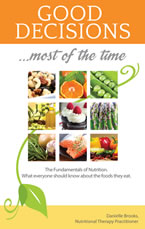Article first published as Book Review: 'Good Decisions...Most of the Time' by Danielle Brooks, NTP, CH on Blogcritics.
November 18, 2014
Good Decisions...Most of the Time
Danielle Brooks, NTP, CH
Aviva Publishing (2014)
ISBN: 9781938686610
New Book Takes Practical Approach to Developing Good Eating Habits
 I love the title of this book: Good Decisions...Most of the Time. I confess I mostly like the “Most of the Time” part of it. But Danielle Brooks is very practical, and while she wants us to make healthy eating decisions, she believes we deserve to enjoy life too. She explains her intention with this title early in the book:
I love the title of this book: Good Decisions...Most of the Time. I confess I mostly like the “Most of the Time” part of it. But Danielle Brooks is very practical, and while she wants us to make healthy eating decisions, she believes we deserve to enjoy life too. She explains her intention with this title early in the book:
“Now, life is too short to skip the occasional bacon cheeseburger with French fries and an ice-cold beer…and life is definitely too short not to eat chocolate. That’s why I titled this book Good Decisions…Most of the Time. When you make Good Decisions…Most of the Time, your body will be better able to deal with the occasional sweet treat or processed food. These indulgences won’t influence your health as adversely when you don’t consume them on a regular basis. In fact, the more Good Decisions you make, the more your cravings for unhealthy items fade.”
And believe it or not, she’s right. When I recently cut down my coffee intake, I found that once I adjusted, the taste of extra coffee just doesn’t do it for me any longer. I also recently switched from salty potato chips to eating veggie chips. I hate veggies. I actually accidentally bought the veggie chips, just thinking they were healthy chips and not realizing they were made with bluck-yuck veggies. But guess what? I started to like them. I think anyone who reads this book and is serious about wanting to make a change, and doing it in baby steps as Brooks advocates, will have similar experiences. Trust me, it’s not what I was expecting, but your waistline and overall body will appreciate it.
Brooks does a lot more than just tell us what to eat and what not to eat. She discusses a wide variety of food and the elements that compose them, and then she gives her final judgment—is this food a good decision or not? The book is divided into different food categories, including carbohydrates, sweet alternatives, grains, and legumes—yes, those gassy beans are included and Brooks tells us how to eliminate the gas when we prepare them. She also includes numerous healthy alternative recipes, many of which really do sound delicious, and she schools us on the healthiest ways to prepare various foods. The book is almost encyclopedic in terms of all the information in it, especially on topics like grains and legumes. It’s like reading a Bible of healthy eating habits with a little wiggle room for people to experiment and decide what is best for them—after all, not everyone’s body reacts to the same foods in the same ways.
Brooks also presents readers with the No Sugar Challenge—I admit I’m not brave enough to take it, but I appreciate what she’s advocating since I have been slowly cutting down my own intake of sugar. I also appreciate that she dismisses a lot of myths, such as that losing weight is just about counting calories. As she states, “This information does not bode well for overweight Americans addicted to sugar who have been told for the last thirty years that in order to lose weight, all we need to do is exercise and decrease our caloric intake. Calories in, calories out, is a mantra that has been repeated for decades. But 100 calories from vegetables function in the body completely differently than 100 calories from a sugary piece of cake.”
Perhaps more important even than all the nutrition information in this book is how Brooks makes us look at our relationship with food. In the sections titled “Psychology of Food,” she asks us to look at the reasons why we overeat and the role of self-esteem and judgment in our relationship with food. In the “Feel the Life That You Are” section, she encourages us not to use food to fill whatever void we may feel in our lives. As she states, “certain individuals who don’t have anything exciting in their lives may be more vulnerable to things that give them a dopamine rush. Food can be one of those things.”
There’s so much in this book, and I think it will benefit anyone reading it, whether read from cover to cover, or used as a reference book that you skip around in. Even if you read it from cover to cover, you’ll be going back to it again and again for its advice and recipes. From understanding why the body needs quality fats, to how to ensure adequate digestion, to discussions about what cans and plastics are good to buy and store food in, there’s something for everyone. That Brooks has the courage to point out the flaws in the bottled water industry alone deserves applause.
Like everyone else, I want to enjoy my food, but even more, I want to enjoy a long and healthy life. I picked up several tips in this book to help me improve the quality of my life and make good decisions...most of the time. I encourage you to read it and do the same.
For more information about Danielle Brooks and Good Decisions...Most of the Time, visit www.GoodDecisions.com.
— Tyler R. Tichelaar, Ph.D., and award-winning author of Narrow Lives and The Best Place

